|
As mentioned in my "5 favorite Smallmouth Flies" post a few weeks ago, any Smallie fisherman worth his salt has a large assortment of Poppers. Smallmouth bass were tailor made for fly fishing. I have often said "pound for pound Smallmouth are the hardest fighting freshwater fish that swims". I dont think any true Smallie addict would argue that statement. Add to that a fish that is willing, dare I say prefers, to take a fly off the surface and you just may have the perfect fly rod fish! I love poppers! I love fishing them, I love tying them, I love designing new ones, I just plain love poppers. What is better than watching a huge frog or fish popper disappear in that tell tale "flush" of water then when you throw the steel to them, they just loose their mind. Watching a popper be eaten may be one of the most exciting things in fly fishing! Below is one of my favorite popper designs, it can be tied very small say on a #4 hook to very large, on a 4/0. This is the pattern I base most of my other popper designs off of. You can change the tail to Cohen's Creatures frog legs for a frog popper, bucktail and saddles for a longer profile or you can even articulate it. Check out this great pattern below... Recipe; This is for the "Bleeding Shad color, we also do Fire tiger and Burple (black / purple) Hook; Gamakatsu B10S (this is a size 1) Thread; Tyer's choice, color to match body (I am using Veevus 6/0) Tail; One white and 1 grey Marabou blood quill tip tied and palmered. Body; complex twist of 1 white schlappen feather and UV Polar chenille, silver Collar; Senyo's laser dub Head; Flymen double barrel Popper hers (this is a medium head) Eyes; Flymen 4mm Ice eyes I am using the Norvise Large Inline , Norvise Magnum Hubs and Norvise Material Clip to tie this pattern.  Tie both feathers in at the same time by the tip at the point where the thread ends right above the barb. Wrap 3 or 4 turns forward, Fold the tip back and wrap back over 3 or 4 tight turns back to front. This "fold in" method will keep the tips from pulling out while you are palmering the feathers forward. 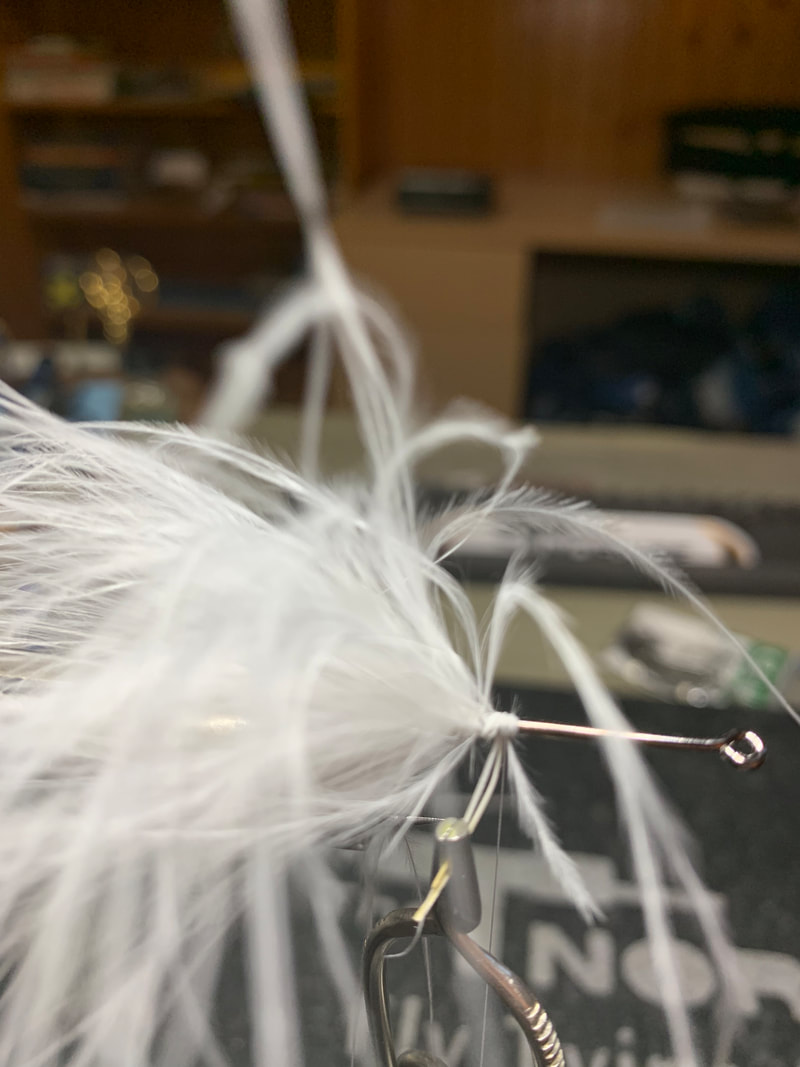 Advance the thread forward to just past the tie in point, half hitch and place the bobbin on the thread post. I like to grab the feather stems with a pair of hackle pliers. Now wrap the feathers forward (or spin your Norvise) taking care not to trap any of the feather under the stem. Once you have wrapped the whole 3/4 of an inch of feather tie off the bare stems with several tight wraps. 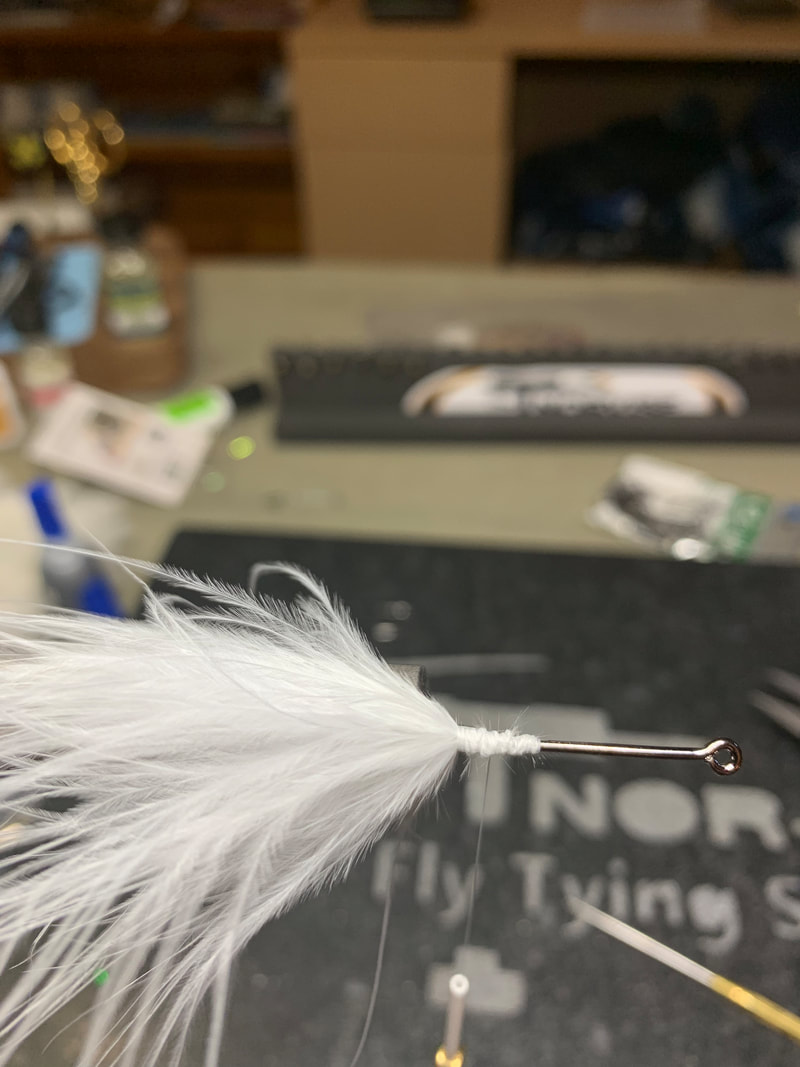 Marabou gets a bad rap in my opinion for not being durable, here is how to make it very strong. Use your bodkin or a tooth brush and stroke back all the marabou, Take care to make sure they are evenly distributed around the hook shank. Now, take your thread and COMPLETLY cover the stems with thread. A drop of Flex Cement here is a fantastic idea. By covering the stems you are protecting the weakest part of the tail. If the stems don't blow up, the tail will last a very long time. I have tales tied in this manner with well over 50 Pickerel landed and the tails look almost brand new. Remember, a Pickerel is a cousin of the Pike and Musky!  Now, hold the feather and the Polar Chenille together with a pair of hackle pliers at the base and spin them together. This will make a dubbing brush of sorts. This "Complex Twist" will blend the feather and the polar chenille together, it will also strengthen the feather by wrapping the core of the polar chenille around the feather stem again, protecting the weakest part of the brush. You will have to use a brush of your bodkin to pick out the fibers. Spin a little and brush, spin and brush, etc. Note; at the bottom there is a link to a video showing how to do this step by spinning your Norvise, it is pretty cool.  Now we are going top build the collar. We will use Senyo's laser dub, red on the bottom and white on the top. Select a small bit, about the thickness of a match stick. Align the the fibers and tie the clump to the hook in the middle. Make sure the material is distributed 180 degrees around the bottom of the hook. Repeat this step in the top with white laser dub.  Cover the entire front of the hook with several layers of thread. This will give the glue something to grip on TEST FIT THE HEAD FIRST! once you are happy with it use ZAP-A-Gap to glue the head to the hook. Warning; you have 1 shot and about 7 seconds before the glue takes hold! Get the head on and situated quickly, if not you may be cutting a perfectly good popper head off and trying again! This is one of my favorite of my designs. I say "My" designs, The palmered tail I learned from Rich Strolis and the body I learned from Eric Snyder. Thanks guys for being part of a great pattern! Till next time...
Tight lines - Tim For a link to a quick video on how to do the complex twist using the Norvise, click HERE. Most of my friends locally that know me know that I am a self proclaimed Smallmouth nut! They are my favorite fish and they are tailor made for fly fishing. Myself, Tyler and my friends spend many hours chasing Smallies each Summer. We have our rods, reels, and watercraft dialed in. We each carry several rods with different lines so we can cover the entire water column from top to bottom and we are very familiar with the rivers that we float. What does all of this mean? Well, we are fortunate enough to land several 18 to 20 inch Smallmouth each year. Our Smallmouth game is tight, and we take pride in that. I always say if you were to look into my working fly boxes you would probably be extremely underwhelmed. You may expect to see box after box with hundreds of different patterns in every color under the rainbow. While I do love tying flies, I love catching fish even more. and when I am all on the water it is all about the fish and catching them! While we are constantly experimenting, tweaking, and coming up with some new patterns. What follows are my core 5 Smallmouth flies. I call these "American Express Flies' because you don't leave home without them (you will have to be over 40 to get that reference) and you can bet if you see me on the river one (or 3) of these will be tied on my tippet. We are full into summer fishing right now (the heat index is 108 as I type this) so I thought for the next couple of blog posts I could do a series of my 5 favorite Smallmouth patterns followed by a step-by-step tutorial in the coming weeks of each pattern. If you are a Smallmouth Junkie like me this is a great opportunity to fill your boxes with some proven producers. Here we go... The ClawdadIf you told me I could only ever fish one fly for Smallmouth this may be the one. This fly has accounted for more 20+" fish in the last 8 years than any other fly I fish. Spawned from the mind of Chuck Craft and available through William Heresnaik in materials or whole at Eastern Trophies Fly Fishing this could possibly be the perfect Smallmouth fly. I typically ALWAYS have one of these rigged and fish it on the bottom on an intermediate or sinking line. Brown (or moccasin) is my go to color, we have also done well on olive and black. I tie mine a little bit different than the original dressing, just a few little tweaks. They probably don't really help and the original is probably best left alone. Fishing is 90% confidence and if I feel more confident in the pattern, I am going to fish it more effectively. PoppersAny Serious Smallmouth angler worth his salt loves fishing poppers. The fishing is very visual and the takes can be explosive. We have used several popper styles over the years, some tied and some purchased. we have settled on these 2 as our favorites. The Boogle Bug. A friend from Virginia turned me on to these several years ago. We got to talking about Smallmouth fishing and he said in his Virginian accent "you ever fish Boogles"? You have to say with the accent or it kind of looses the presentation. I had no idea what he was talking about. Boogles are a hard face popper tied with a hackle skirt and rubber legs. They are very durable and catch a ton of fish. The one thing I noticed is the hard face poppers, especially the Boogles have a higher pitch pop when you strip them. Something I believe the fish really key on at times. If interested check them out here. A few years ago the Flymen company came out with the Double Barrel popper heads. As soon as I saw them I knew I had to try them. The dual sound chambers and the semi-soft popping face gave us a sound that was very familiar. Remember the old Arbogast Hula Popper? The big gaudy, weird looking Bass hard bait? We fished these all the time as kids and they produced a deep, hollow pop it seemed the fish couldn't resist. Well, the Flymen Double Barrel popping heads come the closest to reproducing that sound. We quickly put these heads into some of our current designs (both mine and some of my friends) and the results have been fantastic. O'Neill's Controlled ChaosThis type of fly is really more of a tying style rather than a pattern. Mike Schultz of Schultz Outfitters came up with a great pattern Called a Swinging D. This was the first time I saw a foam popper head turned around backwards to create a diver type of fly. The Swinging D is a GREAT fly, it takes a long time to tie with a lot of steps. Many people, including me, have taken Mike's pattern and tweaked it a bit for various reasons, for me it was strictly tying time. This is probably my favorite pattern in the bunch and, like the Clawdad you will be hard pressed to see me without one if these rigged up. Throw this on an intermediate or a type 2 sink tip on a short leader. The foam head want's to naturally float the fly up and the sink tip wants to pull it down. This self imposed Tug -of War creates an action that is incredible! This pattern is ever changing and here are a few of the variations I have used over the past few years. I am currently working on a all Synthetic version of the fly using some of the great new brushes that have hit the market recently. Like I said, this is more of a basic platform pattern so have fun with it. The Feather Game ChangerAbout 8 years ago a fly hit the market that was truly a revolution in the fly tying world. Blane Chocklett's Game Changer is truly an innovation in the fly tying world. More of a platform for tying multiple patterns the Game changer is available in many variations today. My favorite is the Feather Game Changer. MUCH faster to tie that the original (not fast mind you, they still take 45+ minutes to tie) the best thing about this version is the taper is in the materials, there is little to no trimming. Now you are seeing variations with spun deer hair heads, popper heads and the like making this pattern very versatile. Check out one of the great videos on how to tie this great pattern by searching Feather Game Changer. Shumaker's Shimmering MinnowBrian Shumaker is one of the premier guides on Pennsylvania's Susquehanna River. You may have heard of the Susquehanna before as it is where the famous Clouser Minnow was born. The Shimmering Minnow is a bit of a wide body baitfish pattern, a perfect match for the juvenile Shad the Bass in my area enjoy. Easy to tie and fishy as any fly out there it is easy to see why this pattern has become a staple in my buddy Ed's Fly box. You can tie this in Multiple colors, we prefer the pearl / grey version. To date I believe the shimmering Minnow has landed something like 40 different species from Smallmouth on the Susquehanna to Steelhead in Erie, it is just a great all around fly. Well, there you have it, my top 5 Smallmouth flies. Stay tuned in the coming weeks for tutorials on how to tie all of these great patterns. Till next time...
Tight lines - Tim |
Archives
June 2024
Categories
All
|







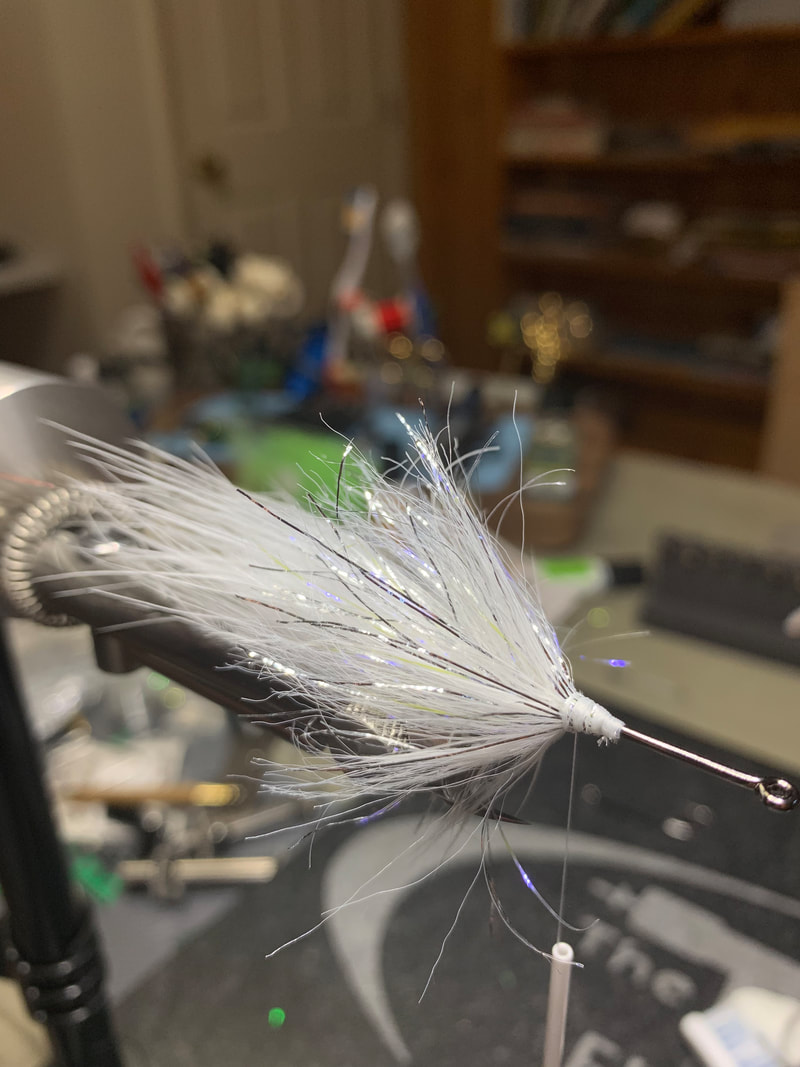


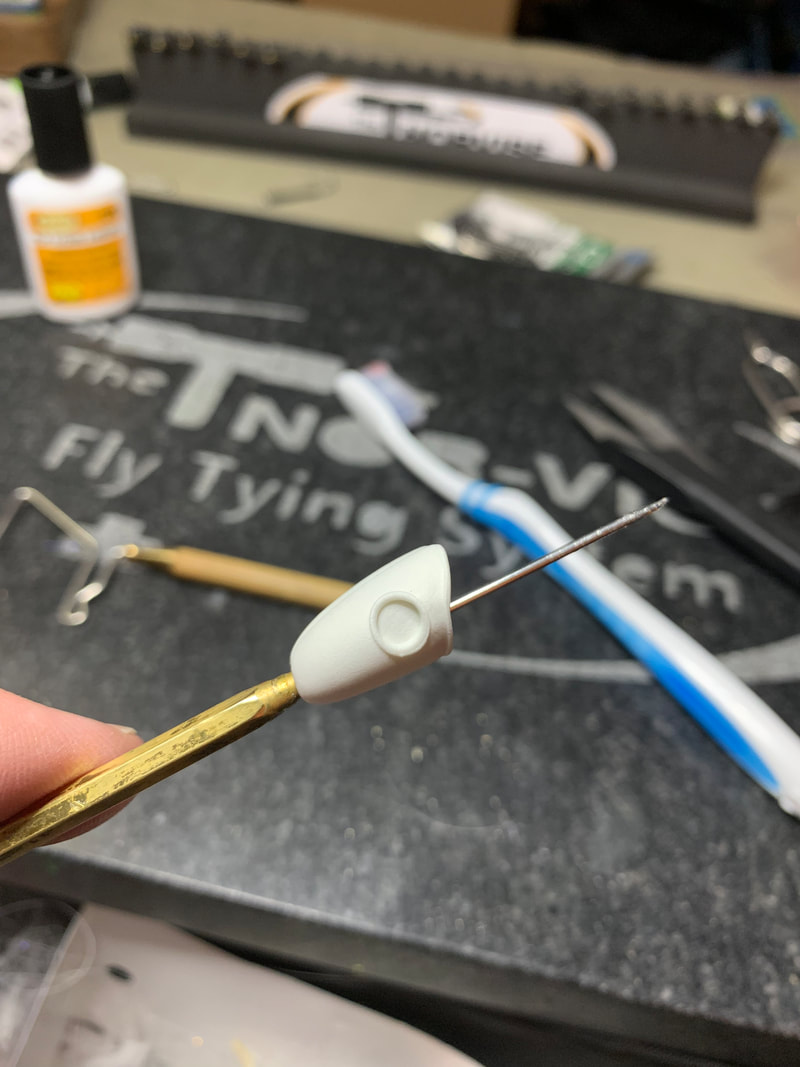
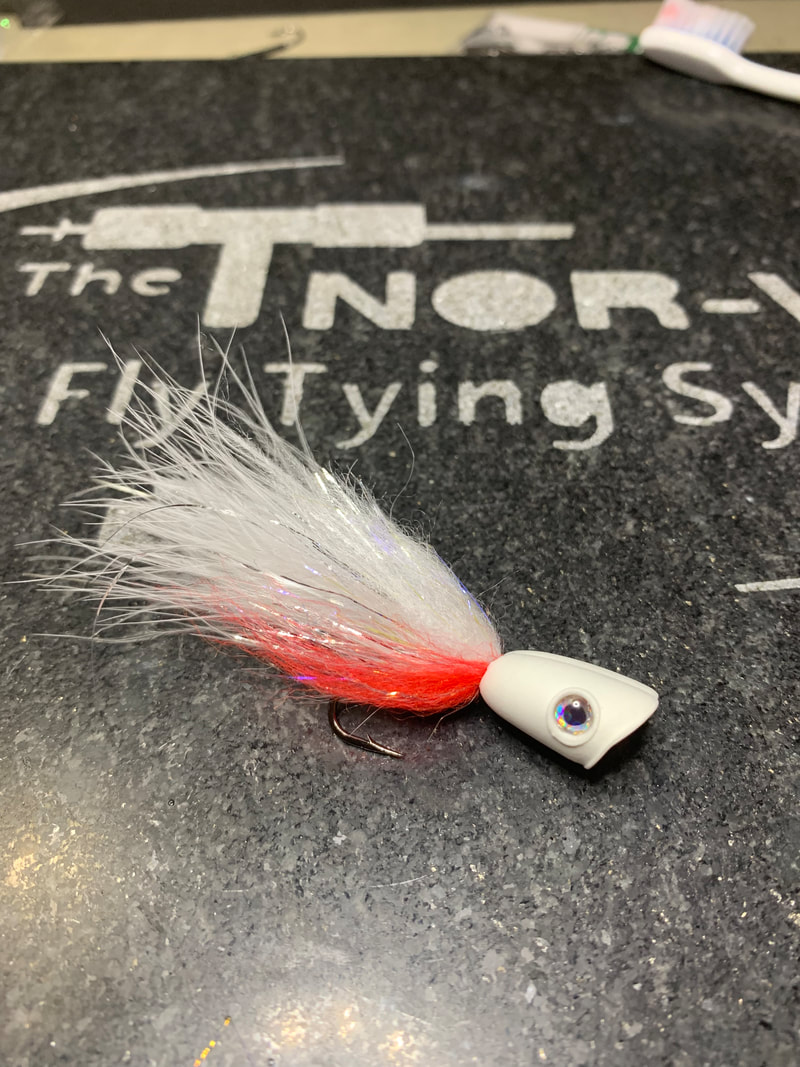














 RSS Feed
RSS Feed
